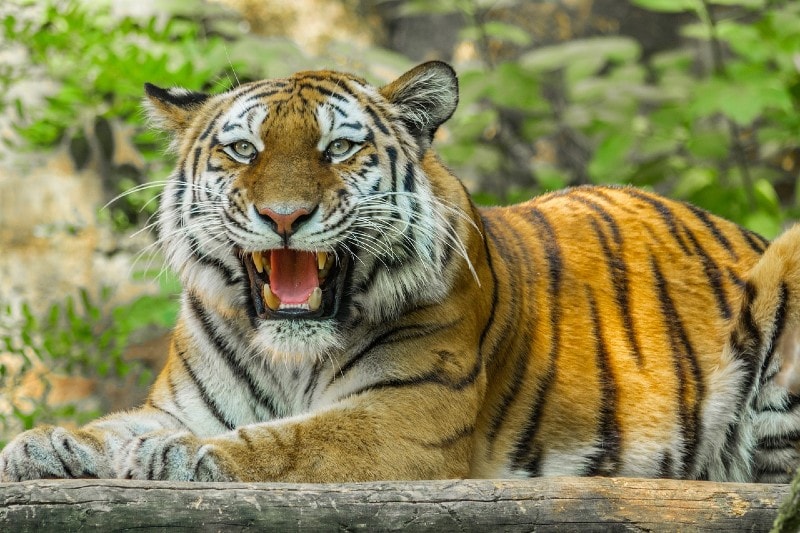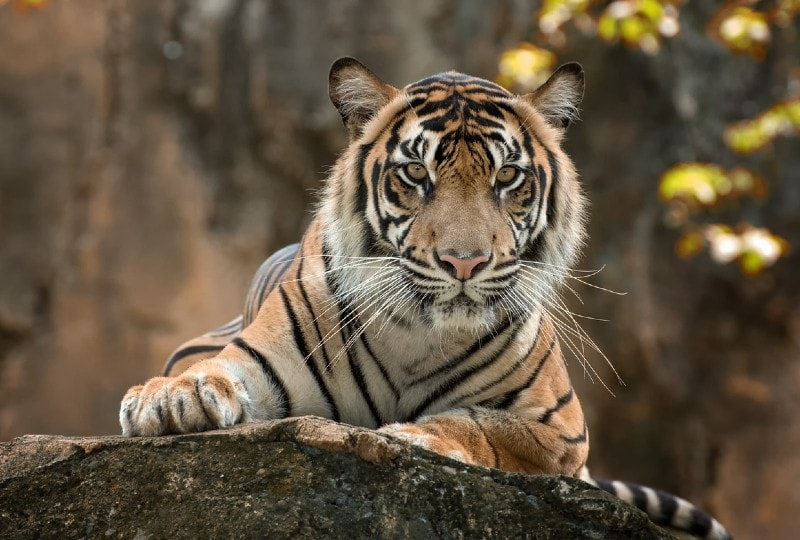Tigers are the largest member of the feline family. Being powerful and majestic creatures, you might be wondering if this apex predator can make the same innocent noises as your average pet cat.
It might be typical for felines to purr, but tigers do not purr. Instead, tigers will roar, growl, or chuff rather than purr or meow like other members of the cat family do. Just like other large felines, such as leopards and jaguars, they chuff—which can sound quite like the purr of your household cat.

Can A Tiger Purr or Meow?
Tigers are incapable of purring. Instead, they produce a low moaning or groaning sound known as chuffing. Tigers cannot meow either because of how their voice boxes are constructed. Members of the cat family that roar are not able to also purr, as they do not have the same hardened bone in their vocal cords that cause the air vibrational sounds that lead to purring.
When a cat exhales and inhales, the small bone located in their vocal cords harden, and the glottis that surrounds the vocal cords, along with air, causes the vibrational sound known as purring. The sound comes from the muscles in the cat’s larynx.
Like other big members of the cat family that cannot purr or meow, tigers have stiff cartilage that runs from their hyoid or lingual bone to the skull, which allows them to roar but not purr. A tiger roars by flapping their larynx quickly up and down, which sends air to the vocal folds. Whereas a small cat dilates and expands their larynx to purr.
Surprisingly, the hyoid bone in tigers that allows them to roar is not found in humans. Small cats have an ossified hyoid bone, which doesn’t allow them to make a deep roaring sound. Whereas tigers and other roaring members of the cat family have a flexible hyoid, allowing them to produce deep vibrational roars, but no purring sound.
The only other members of the cat family known to purr like our domestic cats include cheetahs, pumas, and lynxes, to name a few. Though tigers have been known to make a similar sound to purring, known as “chuffing”.

Chuffing vs. Purring in Cats
Chuffing is a close-range sound that forms one of a tiger’s vocalization sounds. It is often confused as purring, which is not possible for a tiger. The chuffing sound that tigers make can sound like they are blowing air from their nose, accompanied by a low vibrational sound.
Chuffing can only be heard when you are near the tiger because it is produced at a lower and shorter frequency than purring. The sound of chuffing comes from their thick vocal folds, whereas short vocal sounds come from their weaker larynx.
Purring is a sound our domestic cats produce to express how they are feeling. Purring occurs due to air vibrations from the cat breathing in and out, which dilates and constricts the glottis.
The main difference between purring and chuffing is that purring is a vibrational sound that is constant, whereas chuffing is a shorter sound, as if the tiger is inhaling or exhaling air harshly. However, chuffing does share the same function as purring, as it is used by tigers to express how they are feeling.
Why Do Tigers Chuff?
Tigers chuff either to show that they are comfortable, happy, and content, or to greet and socialize with both people and, sometimes, other tigers. The reason for chuffing is not as extensive as domestic cats, who purr for many different reasons, such as happiness, to relieve pain, or to calm themselves during stressful situations.
Chuffing or “prusten” is mainly associated with happy tigers, as this has been observed by zookeepers who notice that tigers chuff when they are receiving attention, feel relaxed, or if they are playing and excited. Some tigers will even chuff to acknowledge and greet zookeepers. They also squint when they chuff to show that they feel content, which is a body language cue to show how they feel aside from just vocalizations.
What Sounds Can a Tiger Make?
Tigers make a variety of different sounds, from a short-pitched roar, to a chuff, hiss, and growl. The sound a tiger makes is dependent on their mood and what they are trying to communicate. Like all members of the cat family, vocalization is as important a part of their communication as body language. Tigers can also hiss or snarl if they feel threatened, instead of roaring like other big cats.

Final Thoughts
Instead of purring like some members of the cat family with rigid hyoid bones, the tiger’s flexible hyoid bone does not allow them to purr. Instead, tigers produce an airy chuffing sound to communicate their content and happiness, much like a cat would when they purr.
Chuffing and purring may sound different in comparison to one another, but they are often confused as the same thing. Surprisingly, not all cats purr, and bigger cats’ constructed vocal cords make them good at roaring, growling, and making other threatening sounds.
Featured Image Credit: Gregorius_o, Pixabay
